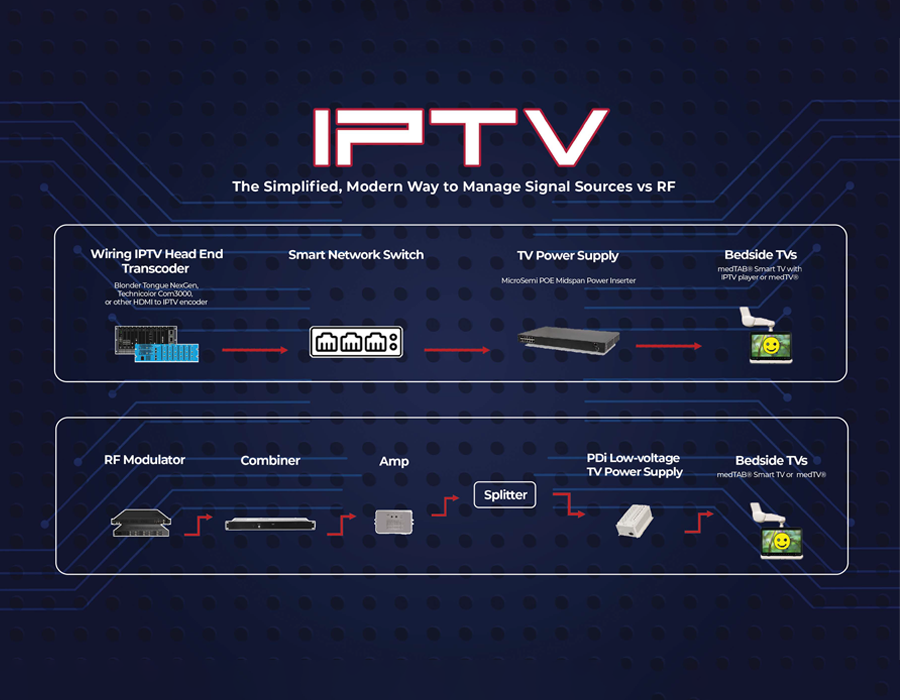The Benefits of IPTV in Healthcare Settings
IPTV is emerging as the next evolution in TV distribution in healthcare facilities. This modern approach brings significant time and cost savings to...

IPTV, Internet Protocol TV, remains a prominent topic in the healthcare industry, steadily gaining momentum as a game-changer. In part one of our IPTV blog series, we explored how IPTV compares to a coax setup, its benefits, and technological advancements.
In this article, we’ll clear up common misconceptions, explore how to power TVs through IPTV, address the question of whether IPTV will replace set-top boxes, and highlight additional benefits. We draw insights from PDi Field Service Technician, Bill Fisher.
Watch the podcast episode HERE.

A common misunderstanding surrounding IPTV is that it is synonymous with streaming services like Netflix. However, IPTV involves transmitting digital television signals over Ethernet rather than coax cable. This allows for remote management, making tasks like modifying TV channel lineups much easier.
Unlike coax setups that require changes to channel line-up or programming packages to be made on-site, IPTV allows administrators to handle some services remotely, eliminating the need to interact with the TV, remote, or any other hardware. This also eliminates disruptions to patients resting in hospital rooms.

Power over Ethernet (PoE) is emerging as a popular power option for facilities using arm-mounted TVs. With PoE, you can power patient TVs using an Ethernet cable, eliminating the need for coax for low voltage power. Its appeal lies in its ability to transmit both power and signal through a single line, making it simpler and easier to maintain. With the power supply housed securely in the IT rack, it's shielded from patient interference.
Additionally, PoE offers a range of over 300 feet, twice what coax cables offer. You can even extend the range further by daisy-chaining additional power supplies. On the other hand, if you use coax to power arm-mounted TVs, you need an individual power supply and AC receptacles. With PoE, a single plug at the base of the arm is all that's needed.

A common question is if Internet Protocol TV will replace interface solutions like set-top boxes and receivers from DirectTV or other providers. The possibility exists. In many cases, it’s possible for the cable company to deliver fiber to the facility, which can then be pushed out as IP. The hardware to manage IPTV is often less expensive than a coax distribution system.
This not only streamlines operations but also frees up space in IT closets. It also enables remote service and troubleshooting, where our PDi ProServices team can securely log into the headend through a VPN and manage the system.

One of the key benefits of IPTV is the customization that it provides through content management software like GENiO by PDi. Tailoring content delivery to specific hospital departments or patient floors enables the dissemination of highly relevant information, promoting better engagement and communication. For instance, content pertaining to newborn care can be directed to the maternity ward, while information regarding heart conditions can be targeted to the cardiovascular unit. With IPTV infrastructure in place, no additional servers or hardware are required for GENiO to operate.

IPTV is reshaping the broadcast landscape with its flexibility, efficiency, and customization options. As the healthcare industry continues to embrace this technology, the potential for innovation and optimization is vast.
If you're considering a refresh or update for your facility, reach out to PDi before finalizing your plans, and we'll assist you in determining the necessary steps to implement IPTV.

IPTV is emerging as the next evolution in TV distribution in healthcare facilities. This modern approach brings significant time and cost savings to...

Patient TVs - Tablets - Telehealth As part of our 40th Anniversary celebration, we’re publishing a special series of blogs throughout 2020. Each...

You've probably heard about Power-over-Ethernet and some of the benefits of PoE. Are you ready to learn more about this cost-effective and...